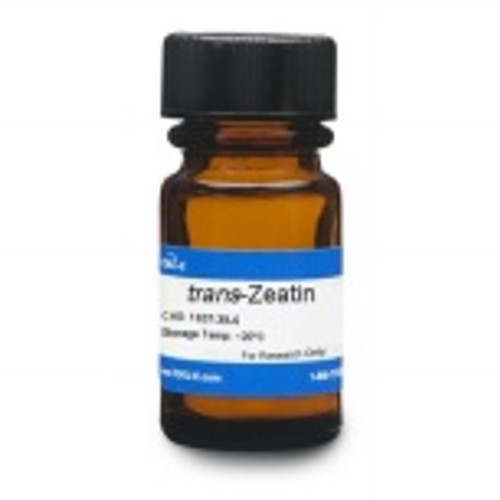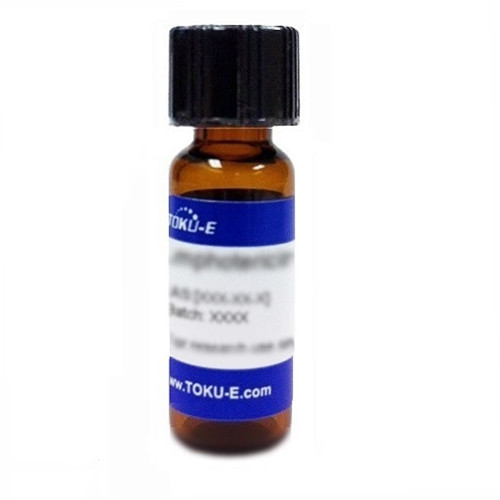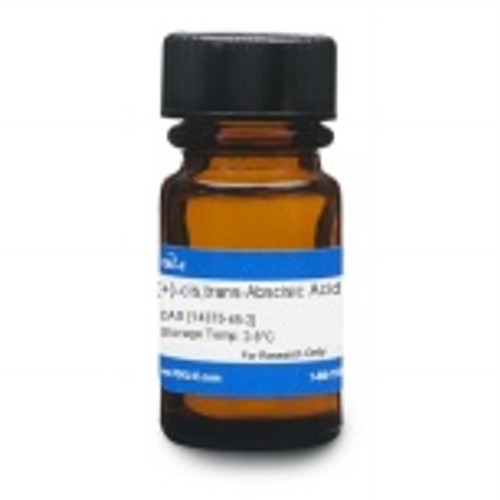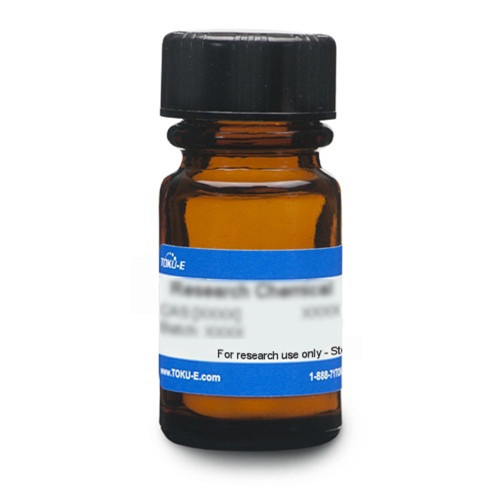Trans-Zeatin is a naturally occurring cytokinin and plant growth regulator routinely used in plant tissue culture to induce shoot formation. Zeatins were discovered in immature Zea mays and occurs in many plant extracts and is the active ingredient in coconut milk. It has two isomers: cis and trans, but the trans isomer is considered more active. Recently, it has been shown that cytokinins like Zeatin function in plant immunity. With pesticides having a negative impact on human health and resistance on the rise, the practical impact of cytokinin-mediated resistance could complement crop protection efforts for added food safety and harvest yield.
trans-Zeatin is slightly soluble in DMSO and very slightly soluble in DMF. It is sparingly soluble in water.
We also offer:
- trans-Zeatin-Riboside (Z004)
| Mechanism of Action | trans-Zeatin evokes its effects through high affinity receptors, including Arabidopsis histidine kinases. Affinity of trans-Zeatin for AHK3 has been reported to be 1.3 nM. |
| Plant Biology Applications | Cytokinins such as trans-Zeatin are used in plant tissue culture to regulate cell division and development, promoting cell division and shoot formation. Cytokinins have also been shown to help plants better cope with environmental stress. They are also involved in nutrient mobilization, apical dominance, and seed germination.
Cytokinins have shown to be involved in plant immunity, mainly to (hemi)biotrophic but also to necrotrophic pathogens. Research has shown that the cis and trans isoforms differentially modulate plant immunity. Both were studied with tobacco-Pseudomonas syringae pv tabaci (Pst) interaction, a well-established pathosystem to analyze cytokinin effects on plant immunity (Grosskinsky et al, 2005). In the tobacco system, trans-zeatin was more active than cis-zeatin but both were able to modulate plant immunity. In this system, the cytokinin-induced resistance is mediated by increased synthesis of two major antimicrobial phytoalexins (scopoletin and capsidiol). This resistance was substantiated by three independent transgenic approaches: a novel pathogen-inducible expression system to induce endogenous CK biosynthesis, and two different ways of exogenously supplying cytokinins. They also used the synthetic 4xJERE promoter which proved to be valuable tool to dissect the role of cytokinins from indirect effects like the developmental stage or metabolic status. Authors also took care to analyze at least 1500 replicate leaves, reflecting more than 62000 infection sites to demonstrate the reproducibility and robustness of the pathogen resistance (Grosskinsky et al, 2011). |
| Eukaryotic Cell Culture Applications | trans-Zeatin is a potential agent for the management of skin photoaging. Treatment with this plant growth regulator induced expression of UVB-induced matrix metalloproteinase-1 (MMP-1) in cultured human skin fibroblasts in a dose-dependent manner (Yang et al, 2009).
Zeatin can promote anti-aging on human skin fibroblasts, acting optimally at 80 uM. Serial passaging in presence of Zeatin prevented cell enlargement, reduced intracellular debris, prevented actin polymerization, and enhanced the cell’s ability to decompose hydrogen peroxide and cope with oxidative stress without inducing additional cell proliferation (Rattan and Sodagam, 2005). |
| Cancer Applications | Cytokinin ribosides have shown to have anticancer activity both in vitro and in vivo, seen from a panel of human cancer cell lines. The isoprenoid cytokinin cis-zeatin riboside has cytotoxic activities seen with a panel of human cancer cell lines. Structural requirements for their cytotoxic activity against human cancer cell lines differ from their requirements in plant bioassays (Voller et al, 2010). |
| Solubility | Slightly soluble in DMSO. Very slightly soluble in DMF. Sparingly soluble in water. |
| References |
Grosskinsky DK et al (2011) Cytokinins mediate resistance against Pseudomonas syringae in tobacco through increased antimicrobial phytoalexin synthesis independent of salicylic acid signaling. Plant Physiol. 2011 Oct;157(2):815-30 PMID 21813654 Grosskinsky DK, Edelsbrunner K, Pfeifhofer H, van der Graaff E, Roitsch T (2005) Cis- and trans-zeatin differentially modulate plant immunity. Plant Signal Behav. 2013 8(7):e24798 PMID 23656869 Ha S and Vankova R (2012) Cytokinins: Metabolism and function in plant adaptation to environmental stresses. Trends Plant Sci. 3(172):172-179 Takei K et al (2004) Arabidopsis CYP735A1 and CYP735A2 encode cytokinin hydroxylases that catalyze the biosynthesis of trans-Zeatin. J Biol Chem 279(40):41866-72 PMID 15280363 Havlova M et al (2008) The role of cytokinins in responses to water deficit in tobacco plants over‐expressing trans‐zeatin O‐glucosyltransferase gene under 35S or SAG12 promoters. Plant, Cell & Environment 31: 341-353 PMID 18088334 Rattan SI and Sodagam L (2005) Gerontomodulatory and youth-preserving effects of Zeatin on human skin fibroblasts undergoing aging in vitro. Rejuvenation Res. 8(1):46-57 PMID 15798374 Voller J et al (2010) Anticancer activity of natural cytokinins: A structure-activity relationship study. Phytochem. 71(11-12): 1350-1359 PMID 20553699 |








